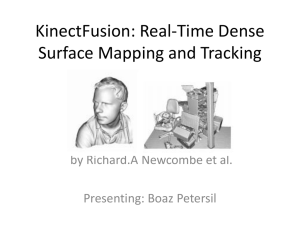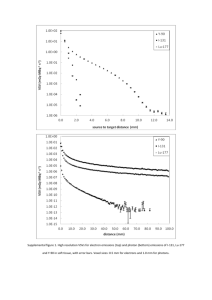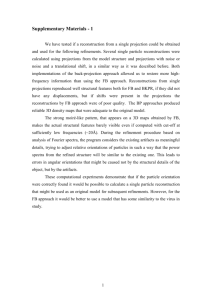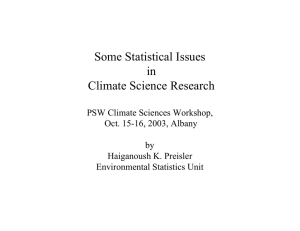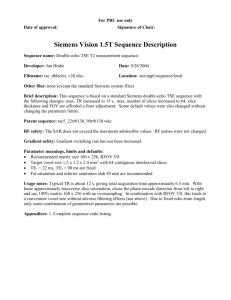Visualizing Monte Carlo computed radiation energy values by using a... by Brett A Donahue
advertisement
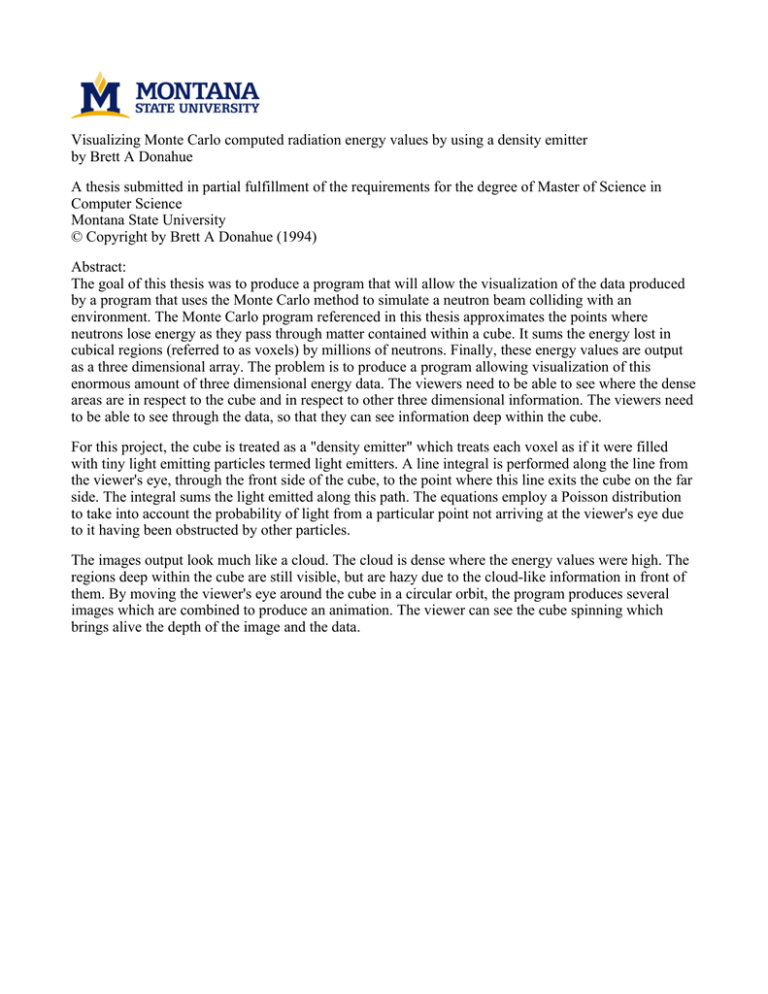
Visualizing Monte Carlo computed radiation energy values by using a density emitter
by Brett A Donahue
A thesis submitted in partial fulfillment of the requirements for the degree of Master of Science in
Computer Science
Montana State University
© Copyright by Brett A Donahue (1994)
Abstract:
The goal of this thesis was to produce a program that will allow the visualization of the data produced
by a program that uses the Monte Carlo method to simulate a neutron beam colliding with an
environment. The Monte Carlo program referenced in this thesis approximates the points where
neutrons lose energy as they pass through matter contained within a cube. It sums the energy lost in
cubical regions (referred to as voxels) by millions of neutrons. Finally, these energy values are output
as a three dimensional array. The problem is to produce a program allowing visualization of this
enormous amount of three dimensional energy data. The viewers need to be able to see where the dense
areas are in respect to the cube and in respect to other three dimensional information. The viewers need
to be able to see through the data, so that they can see information deep within the cube.
For this project, the cube is treated as a "density emitter" which treats each voxel as if it were filled
with tiny light emitting particles termed light emitters. A line integral is performed along the line from
the viewer's eye, through the front side of the cube, to the point where this line exits the cube on the far
side. The integral sums the light emitted along this path. The equations employ a Poisson distribution
to take into account the probability of light from a particular point not arriving at the viewer's eye due
to it having been obstructed by other particles.
The images output look much like a cloud. The cloud is dense where the energy values were high. The
regions deep within the cube are still visible, but are hazy due to the cloud-like information in front of
them. By moving the viewer's eye around the cube in a circular orbit, the program produces several
images which are combined to produce an animation. The viewer can see the cube spinning which
brings alive the depth of the image and the data. VISUALIZING MONTE CARLO COMPUTED RADIATION ENERGY
VALUES' BY USING A DENSITY EMITTER
by
Brett A. Donahue
A thesis submitted in partial fulfillment
of the requirements for the degree
of
Master of Science
in
Computer Science
MONTANA STATE UNIVERSITY
Bozeman, Montana
June 1994
ii
APPROVAL
of a thesis submitted by
Brett A. Donahue
This thesis has been read by each member of the thesis
committee and has been found to be satisfactory regarding
content, English usage, format, citations, bibliographic
style, and consistency, and is ready for submission to the
College of Graduate Studies.
Chairperson,
Date
aduate Commi
Approved for the Major Department
-? I I
Date
oi
4Hea d , Maj or Department
Approved for the College of Graduate Studies
Date
Graduate Dean
e
iii
STATEMENT OF PERMISSION TO USE
In presenting this thesis in partial fulfillment of the
requirements
for
a
master's
degree
at
Montana
State
University, I agree that the Library shall make it available
to borrowers under rules of the Library.
If I have indicated my intention to copyright this thesis
by including a copyright notice page,
only for
scholarly purpose,
copying is allowable
consistent with
prescribed in the U.S. Copyright Law.
"fair use"
as
Requests for permission
for extended quotation from or reproduction of this thesis in
whole or in parts may be granted only by the copyright holder.
Signature
Date
•7-f-
tI H
iv
TABLE OF CONTENTS
Page
CHAPTER I
I N T R O D U C T I O N ........... ................... .......... I
CHAPTER 2
THE VARYING DENSITY EMITTER
........................
3
in io t-' co
CHAPTER 3 ,
GDER PROGRAM DESIGN
......................
Program Overview
....................
Class Instantiations
...............
The MATRIX, POINT, and VECTOR Classes
The DE C l a s s ..........................
10
The BNCT C l a s s ........................ .' . . . 13
The IMAGE C l a s s .................................. 15
The YBUFFER C l a s s ................................ 16
The VOXEL C l a s s .................................. 20
The VIEWER C l a s s ................................ 25
Main F u n c t i o n .................................... 27
CHAPTER 4
R E S U L T S ..........................
29
GDER U s a g e .......................................29
Future W o r k .......................................30
S u m m a r y ......................................... 31
R E F E R E N C E S ..................................................33
REFERENCES C I T E D ........... -....................... . 3 4
A P P E N D I C E S ..................................................35
APPENDIX A
PARAMETER FILE FORMAT AND CONTENTS
........... 36
APPENDIX B
VOXEL FILE F O R M A T ................................ 38
V
LIST OF TABLES
1.
2.
3.
4.
5.
6.
7.
8.
9.
The
The
The
The
The
The
The
The
The
Page
MATRIX class
POINT class.
VECTOR class.........................................10
DE class......................
11
BNCT class........................................... 14
IMAGE class.......................................... 15
..................................... 17
YBUFFER class.
VOXEL class.......................................... 21
26
VIEWER class.....................
10 vo
Table
vi
LIST OF FIGURES
Figure
1.
2.
3.
4.
5.
6.
7.
8.
9.
Page
Class instantiations. ....................
7
A Sliver projected onto aviewing plane pix e l .
. . . 18
Scan lines across the projected edges............... 19
The voxel cube ..........
22
Voxel cube traversal.................................24
Output Example I ................................
32
Output Example 2 ................................... . . 3 2
Example parameter file.............................. 37
Example voxel data file............. .................. 38
vii
ABSTRACT
The goal of this thesis was to produce a program that
will allow the visualization of the data produced by a program
that uses the Monte Carlo method to simulate a neutron beam
colliding with an environment.
The Monte Carlo program
referenced in this thesis approximates the points where
neutrons lose energy as they pass through matter contained
within a cube.
It sums the energy lost in cubical regions
(referred to as voxels) by millions of neutrons.
Finally,
these energy values are output as a three dimensional array.
The problem is to produce a program allowing visualization of
this enormous amount of three dimensional energy data.
The
viewers need to be able to see where the dense areas are in
respect to the cube and in respect to other three dimensional
information.
The viewers need to be able to see through the
data, so that they can see information deep within the cube.
For this project, the cube is treated as a "density
emitter" which treats each voxel as if it were filled with
tiny light emitting particles termed light emitters.
A line
integral is performed along the line from the viewer's eye,
through the front side of the cube, to the point where this
line exits the cube on the far side.
The integral sums the
light emitted along this path. The equations employ a Poisson
distribution to take into account the probability of light
from a particular point not arriving at the viewer's eye due
to it having been obstructed by other particles.
The images output look much like a cloud.
The cloud is
dense where the energy values were high.
The regions deep
within the cube are still visible, but are hazy due to the
cloud-like information in front of them.
By moving the
viewer's eye around the cube in a circular orbit, the program
produces several images which are combined to produce an
animation. The viewer can see the cube spinning which brings
alive the depth of the image and the data.
viii
GLOSSARY OF TERMS AND ACRONYMS
BNCT
Boron
Neutron
Capture
Therapy,
the
program
sponsored by the Department of Energy through INEL
for which GDER was written
BNCT
the class in GDER that handles the BNCT B-spline
surfaces
DE
the class in GDER that performs the density emitter
functionality [SABE88]
GDER
General Density Emitter Renderer, the name of the
program discussed in this thesis
INEL
Idaho National Engineering Laboratories
MRI
magnetic resonance images
PRP
projection reference point [F0LE94]
sliver
the entire section of a voxel that is projected
onto one pixel of the image.
(See Figure 2, Page
18. )
VIEWER
the class in GDER that does viewing functions
voxel
volume element,
space
VOXEL
the class in GDER that handles voxels
VRC
viewing-reference coordinates [FOLE94]
VUP
the vector that defines the up direction [POLE94}
ybuffer
my algorithm to project 3D voxels onto the viewing
plane
YBUFFER
the class
algorithm
in
similar to a pixel,
GDER
that
implements
but in three
the
ybuffer
I
CHAPTER I
INTRODUCTION
This
graphics
thesis
program
represents
titled
the
development
General
Density
of
a computer
Emitter
Renderer
(GDER) that will aid in the visualization of the data produced
by programs used in the Boron Neutron Capture Therapy (BNCT)
radiation treatment planning at Montana State University (MSU)
and the Idaho National Engineering Laboratory (INEL) in Idaho
Falls, Idaho.
The BNCT radiation treatment planning program
[WESS92] takes digitized medical images as input and produces
three
dimensional
(3D)
B-Spline
surfaces
defining various
anatomical regions such as the skull, brain, tumors, eyes, and
sinus cavity.
These region definitions are then used as input
to the Monte Carlo program at INEL [WHEE94]. Monte Carlo uses
stochastic methods based upon physical properties to simulate
hundreds of millions of neutrons interacting with the matter
in the treatment environment.
neutrons
are
traced
is
The cubical volume where these
segmented
cubical regions or voxels
into
equal
(volume elements).
sized,
small
The energies
lost by the neutrons within each of these voxels are totaled
and output to a file.
A program is needed to combine the data from the B N C T .
2
program and the Monte Carlo program into one comprehensive
image.
The program needs to produce an image that will allow
viewers to visualize the enormous amount of energy data with
respect to itself, with respect to the BNCT B-spline surfaces,
and with respect to the entire cubical volume considered by
Monte Carlo.
fly
around
Also, the program should be able to produce a
animation
of
the
cube
to
enhance
the viewer's
perception.
The major problem to overcome is how to perform volume
rendering upon the cube of energy values, so that the viewers
are able to see the "hot spots" where large amounts of energy
were deposited by the neutrons, no matter how deep within the
cube they reside.
treated
as
a
To do the
rendering,
the
cube will be
"varying density emitter", and the
algorithm
presented in the paper "A Rendering Algorithm for Visualizing
3D Scalar Fields" by Paolo Sabella [SABE88] will be followed
with some improvements that will be discussed in chapter 2.
3
CHAPTER 2
THE VARYING DENSITY EMITTER
A density emitter
emitting particles
these particles
is a volume filled with tiny light
termed
light emitters.
The
density of
is defined by a 3D scalar field.
In this
application, we have discrete 3D scalar data defined by the
voxels representing the cubical regions of energy, so that the
density of the light emitters within a voxel is equal to the
value stored in the cubic array.
The voxels are equal sided
and there are an equal number of voxels in each direction, so
the entire volume has the shape of a cube.
To render the density emitter cube, a line integral is
performed along a straight line from the viewer's eye, through
a pixel on the image, through the front surface of the density
emitter
cube,
and to the back surface
of the
cube.
This
integral sums the tiny amounts of light emitted by the light
emitters.
accounts
A Poisson distribution in the integrated equation
for the probability of
light not arriving at the
viewer's eye due to it colliding with other light emitters
along the path.
A summation is performed rather than analytic
integration because of the discrete scalar field.
4
The algorithm to perform the volume rendering by Paolo
Sabella [SABE88] is followed closely with one major deviation.
Because the light emitters must be considered from the closest
to
the
furthest,
perform
the
Sabella
summation
that
integral for each pixel.
used.
used
a
ray
traced
In ODER,
tracing
the
path
approach
of
the
line
a different approach is
A front to back traversal of voxels is performed.
traversal
order
must
ensure
that
to
for
each
voxel
The
being
processed, every voxel that lies in front of it has previously
been processed.
A specialized scan line algorithm with a y-
buffer [FOLE94] projects light emitted from within one voxel
onto
the
image.
This
method
was
written
to
handle
the
projection of a volume instead of a polygon, so the depth is
also taken into account.
With my algorithm, each voxel needs
to be considered only once per image, whereas the ray tracing
approach considers every voxel that affects a particular pixel
for each pixel in the image.
5
CHAPTER 3
GDER PROGRAM DESIGN
Because
GDER
is
written
in
C++,
object
oriented
terminology will be used to describe the program design and
implementation.
The functionality is contained within nine
classes:
• MATRIX,
• POINT,
)
• VECTOR,
• DB,
• BN C T ,
• IMAGE,
• YBUFFER,
• VOXEL, and
• VIEWER.
Each of these classes is discussed in detail in the following
sections.
The most basic classes will be discussed first
because instantiations of the basic classes will be members of
the more intricate classes.
6
Program Overview
The steps that GDER takes to produce the images are:
A) initialization which includes:
1) input of the parameter file,
2) input of the voxel data,
3) input of the BNCT B-splines surface data,
4) initialize the DE class member, and
5) initialize the IMAGE class members;
B ) rendering the scene which involves:
1) rendering the density emitter by
a) traversing the voxels from the nearest to
the furthest,
b)
using a specialized scan
and
y-buffer
to
provide
line
algorithm
each
voxel's
contents to the density emitter summation
equations, and
c)
copying
the
density
emitter's
stored
intensity values into the image;
2) rendering the BNCT B-spline surfaces.into the
image;
C ) saving the image to disk; and
D) changing the viewing angle and looping to step B.
7
Class Instantiations
Figure I shows which classes use instantiations of other
classes.
Showing how these classes use instantiations of each
other should help show the program flow.
The function MAIN is
the routine in the program that uses only the VIEWER class
which uses all of the other classes.
/
MATRIX
~
^
VECTOR)<$— > ( POINT )
A
i
\
[ IMAGE )
/—
4
(
>-
~
[ VO XEL)
BNCT )
A
^
(YBUFFER]
A
^
f DE )
a
( VIEWER
A
^---- 5=—
A
(
.
MAIN
]
!Ti---
Figure I.
Class instantiations.
The MATRIX. POINT, and VECTOR Classes
The MATRIX> POINT, and VECTOR classes handle the storage
and
manipulation
for
matrices,
points,
and
vectors.
The
methods perform the vector math associated with these types.
All of the members of these classes are private, but some of
the members are friends of the other classes.
vector math to be performed across classes.
This allows
For example, a
matrix multiplication may be performed upon a point,
or a
vector may be calculated by the location of two points.
The contents of the MATRIX, POINT, and VECTOR classes
with brief definitions are in Tables I, 2, and 3 respectfully.
9
Table I.
The MATRIX class.
CLASS MEMBER
PURPOSE
M
a 4x4 array representing a matrix
CLASS METHOD
PURPOSE
MATRIX
initializes the matrix by calling
ZeroMatrix
ZeroMatrix
zeros this matrix
Mult
multiplies this by the given MATRIX
MatMultPoint
multiplies and stores the given MATRIX by
the given POINT
GetTransMatrix
creates and stores a translate matrix
from the 3 floats given
GetRotateMatrix
creates and stores a rotate matrix from
the 3 floats supplied
GetScaleMatrix
creates and stores a scale matrix from
the 3 floats supplied
Table 2.
The POINT class.
CLASS MEMBER
PURPOSE
x, y, z
the values representing a point
CLASS METHOD
PURPOSE
POINT
initializes this POINT to a given value
Set
assigns a value to this point
X
returns the value stored as the x member
Y
returns the value stored as the y member
Z
returns the value stored as the z member
MatMultPoint
multiplies the given POINT and the given
MATRIX and stores the value
CalcDistance
returns the distance between two POINTS
10
Table 3.
The VECTOR class.
CLASS MEMBER
PURPOSE
x7 y, z
the values representing a vector
CLASS METHOD
PURPOSE
VECTOR
initializes this VECTOR to a given value
Set
assigns a value to this vector
X
returns the value stored as the x member
Y
returns the value stored as the y member
Z
returns the value stored as the z member
Normalize
divides this vector by the magnitude to make
it unit length
calculates the cross product of this vector
CrossProd
and one other provided VECTOR
calculates the dot product of this v e c t o r '
DotProduct
and one other provided VECTOR
Magnitude
returns the magnitude of this vector
Vectorize
calculates and stores the vector defined by
the two POINTS provided
The DE Class
The
DE
(density
of
emitter)
class
the calculations
is
related
responsible
performing
all
emitter.
The methods and members are listed in Table 4.
for
to the density
11
Table 4.
The DE class.
CLASS MEMBER
PURPOSE
OverIntensity
the number of pixels that have an intensity
more than the maximum value of 1.0
struct
DEDataType
the structure that contains values stored
for each pixel, which are:
TransM - the pixel's transmittance
Intensity - the pixel's intensity
MaxDensity - the maximum density ever
applied to this pixel
DepthOfMaxDen - the depth at which
MaxDensity occurred
DEData
the array of DEDataType that stores the
values for each pixel
Tau
part of the density emitter equation,
logarithmically adjusts the density values
[SABE88]
DensityTran
part of the density emitter equation,
determines how opaque the voxels are
[SABE88]
Color
a boolean indicating of pseudo color is
calculated
MaxMaxDensity
the highest density recorded for all pixels
MinDepth,
MaxDepth
the max and min depths, used for calculated
the saturation (HSV) [SABE88]
CLASS METHOD
PURPOSE
DE
initializes all members by calling clear
Clear
initializes all members, must be called
prior to producing each image
Apply
applies a density of light emitters to a
pixel
GetRGB
calculates and return the color of a pixel
SetDepthRange
stores the max and min depth of the voxel
cube
OverInt
returns the value stored in OverIntensity
12
Initially,
the
transmittance
values
are
set
to
1.0
indicating that all of the light from the particle emitter
reaches the viewing plane. The intensity is set to 0.0, so it
contains a blank image.
The method Apply performs
the summation equation that
calculates the intensity of each pixel.
This method has five
parameters:
= i, j— the viewing plane coordinates of the pixel,
° length— the length of the voxel "sliver" (see
Figure 2, page 18) that is projecting upon
this pixel,
° density— the density of the particle emitters in the
"sliver", and
o depth— the depth of the "sliver" in world coordinates.
The
intensity
of
light
reaching
the
viewing
plane
is
calculated, summed, and stored within members of this class.
The method Apply is invoked once for each pixel projected upon
by each voxel.
The successive calls of Apply for one pixel
must have increasing depth values, or the equations will not
work properly.
The methods VIEWER::Render, VIEWER::ViewVoxel,
and VOXEL::GetVoxelTraversalData perform this front to back
traversal of voxels.
The class YBUFFER handles the projection
of
the
the
plane.
voxels
onto
appropriate
pixels
of
the viewing
13
The BNCT Class
The BNCT class stores and manipulates the BNCT data.
It
inputs the data from a file; translates, rotates, and scales
the data; and renders the data.
The methods and members are
listed in Table 5.
The
BNCT data and the voxel
coordinate system.
data each have their own
The rotate.and scale are constant values,
but the shift values are dependent upon the data set.
When
the voxel data is read from the file, its location in world
coordinates is determined and the shift values are sent to the
BNCT class via the method SetShift.
called,
the
necessary
translates,
When the method TRS is
rotates,
and
scales
are
performed on the BNCT data, so that it has the same coordinate
system as the voxel data.
The method Render renders the BNCT data and stores the
results in an instantiation of the IMAGE class.
Rendering of
the BNCT data consists of drawing a line from each point to
each adjacent point;
BNCT bodies.
thus,
drawing the meshes defining the
The color of the lines for each body are read in
as part of the BNCT data.
The lines are depth cued, but that
is performed within the method IMAGE::DrawLine of the IMAGE
class.
By replacing the Render method, the user may employ
14
other rendering algorithms.
Included within the source is
another, unused Render method which produces a file of "raw"
triangle data.
The program RAWTOPOV can convert the file into
an input file for The Persistence Of Vision Ray Tracer (POVR a y ), so the BNCT data can be ray traced.
POV-Ray can be
acquired via
ftp
Both RAWTOPOV and
at wuarchive.wustl.edu on
internet.
Table 5.
The BNCT class.
CLASS MEMBER
PURPOSE
shift _ x , shift _ y ,
shift_z
the values that translate the BNCT data
to the voxel data
BNCTData
the "root" of linked list that contains
the BNCT data
CLASS METHOD
PURPOSE
GetEmptyBNCTBody
returns an initialized linked list node
BNCT
initializes the class members
BNCTRead
reads in the BNCT data from a file and
builds the data structure
SetShift
sets the three translate values
TRS
TRS (translates, rotates, and scales)
the BNCT data
Free
frees the allocated memory in the BNCT
data structure (not implemented)
Render
renders the BNCT image and stores the
pixel values in the image class
provided
15
The IMAGE Class
The IMAGE class provides for storage and manipulation of
an image.
Member functions plot points and draw depth cued
lines into the image.
The IMAGE class members and methods are
tabulated in Table 6.
Table 6.
The IMAGE class.
CLASS MEMBER
PURPOSE
ImageDataType
a structure defining a pixel in the image
image
a 2D array for storing the image
MaxDepth,
MinDepth
the minimum and maximum depths which are
used in depth cuing
CLASS METHOD
PURPOSE
IMAGE
initializes and clears the image
Set
sets one pixel's data (color)
Get
returns one pixel's data (color)
SaveTGA
saves the image as a Targa file
Clear
clears the image for future processing
SetDepthRange
sets the maximum and minimum depths which
are used in depth cuing
DrawPixel
draws one pixel into the image
DrawLine
draws one depth cued line into the image
16
The image must be cleared by calling the method Clear
prior to any processing.
be
invoked
to
set
Then, the method SetDepthRange must
the maximum
and minimum possible
depth
values, so that depth cuing of lines may be performed.
The
Basic Incremental Algorithm [FOLE94] is used for line drawing.
Because very little time is spent drawing lines compared to
computing the
density emitter equations,
the
time was
not
taken to implement a faster, more efficient algorithm.
The
method
SaveTGA
without RLE compression.
saves
the
image
as
a
Targa
file
Within this method, there is unused
source code that saves a PPM (Portable Pix Map) which may be
more compatible with UNIX image utilities.
The YBUFFER Class
The algorithms used in the YBUFFER class were derived
from the scan line algorithm for drawing filled polygons that
uses a y-buffer [FOLE94]. Many modifications were necessary,
so that depth is taken into account when voxels are projected
onto the viewing plane.
The YBUFFER class contents with a
description is in Table I .
17
)
Table 7.
The YBUFFER class.
CLASS MEMBER
PURPOSE
const EMPTY
indicate that a y-buffer index is empty
struct {
x[5]
z[5]
} YBuff[]
stores all y-buffer info.
x array stores the x locations of the lines
z array stores the depths of the lines
ylndex
stores the next index in YBuff to be drawn
yBuffSorted
indicates that the x arrays are sorted
CLASS MEMBER
PURPOSE
SetLine
puts a line into the y-buffer
GetNextRange
returns an x range and depths to work on and
a boolean indicating another range existed
SortYBuff
sorts each of the x arrays in the YBuff
YBUFFER
constructor, initializes all of the data
Set
receives 8 points in usual order (A,B,...,G)
and enters the cube into the y-buffer
GetNextPoint
returns the next pixel data to be drawn
returns a boolean to indicate a range was
available
The YBUFFER class takes a single voxel and breaks it into
separate "slivers" where each sliver projects onto one pixel
of
the viewing plane.
(See Figure 2.)
Also,
the member
functions will output the distance that the sliver is from the
viewing plane (the depth) and the total length of the sliver.
18
Sliver
Projection Plane
(Image)
Figure 2.
Voxel
A Sliver projected onto a viewing plane pixel.
CCCCCCC
The user of this class must first call the method Set
which takes 8 points defining a voxel and loads the 12 edges
of the voxel into the y-buffer by calling the method SetLine
12 times.
SetLine stores the x values and the depths of the
19
3 lines
4 lines
5 lines
Voxel
Projection Plane
(Image)
Figure 3.
Scan lines across the projected edges.
line at the x values in the range of the y-buffer representing
the y values of the line.
As Figure 3 shows, at each of the
scan lines, there will be either 0, 3, 4, or 5 edges of the
voxel which is how many ranges must be processed.
If there
are 5 edges, then there are 4 ranges.
Once the method Set has
finished,
the user repeatedly
calls the method GetNextPoint to return one sliver at a time
from the current scan line range.
has not yet been retrieved),
If a range is empty (or one
GetNextPoint calls the method
GetNextRange which calculates and returns the definition of
20
the
next
range
to
be
processed.
GetNextRange
linear
interpolates the depth at each end of one section of the scan
line, marks that range as processed, and returns the values to
the function GetNextPoint.
If the entire voxel is processed
and no ranges are available, GetNextRange returns a zero to
GetNextPoint which returns a zero indicating that processing
of this voxel has been completed.
The VOXEL Class
I
The VOXEL class provides all functionality and storage
for the voxels and the voxel cube.
The member and methods of
the VOXEL class are listed in Table 8.
The voxel data are read and stored in a 3D array by the
method ReadAndSet.
For a description of the format of the
voxel file, see Appendix B.
calculated
from
coordinates.
Each
represented by
points
are
the
an
labeled
The location of the voxels are
location
of
the
of
eight
instantiation
A
the
through
corners
of
H
voxel
the
and
of
POINT
are
coordinates as seen in Figure 4, page 22.
cube
the
located
initially
at
the
origin,
but
the
world
cube
class.
is
The
in world
The width, height,
and length of the voxels are all one centimeter;
distance as the voxel data values.
in
the same
The center of the cube is
method
TRS
translates,,
21
rotates, and scales these eight points which moves the entire
cube
into
the
first
quadrant
in
world
coordinates.
The
viewing plane x and y coordinates are equal to the world x and
y values, so when projections are performed, no calculations
are necessary.
(See Figure 4.)
Table 8.
The VOXEL class.
CLASS MEMBER
PURPOSE
size
the max voxel array index
M a x , Min
may need for adjusting values
A, B , C , D , E ,
F, G, H
define the cube in 3D space
AB f A D j AE
orthogonal, normalized vectors from A
VoxelLWH
voxel width, length, and depth in 3D
CLASS METHOD
PURPOSE
ReadAndSet
reads and stores voxel input file
Reset
restores cube to original location for
the next TRS
GetVoxel
returns the value of the voxel
GetApproxVoxel
returns the linear approximate value of
the voxels
SIZE
returns value in member size
VOXELLWH
return value in member VoxelLWH
TRS
translates, rotates, and scales the voxel
cube
GetVoxelTraver
salData
determines how to traverse the voxel cube
from front to back
GetVoxelCoords
returns the 8 corner points of a voxel
GetCubeCoords
returns the 8 corner points of the voxel
cube
22
z axis
x axis
Figure 4.
The voxel cube.
The method GetVoxelTraversalData determines in what order
the voxels should be traversed, so they are processed from the
closest to the furthest.
By doing this, the density emitter
equations in the method D B : :Apply will process the slivers for
each pixel from the closest to the furthest.
The following
argument explains how the order is determined, but the actual
traversal
of
VIEWER::RENDER.
the
voxels
is
performed
in
the
method
First, the very closest corner of the cube is
23
found,
then the second,
and finally the third.
The three
voxels at these corners are numbered 1,2, and 3 respectively.
(See Figure 5.)
First, voxel I is processed, then each voxel
on the path to voxel
Figure 5.
2 is processed.
This is line
Once that row has been processed,
the
'a' in
adjacent
parallel row in the direction of the third closest voxel is
processed.
Once
that
completed (lines 'a',
entire
'b',
first
layer
of
voxels
is
'c', and 'd'), the next layer of
voxels is completed which starts with line 'e' in Figure 5.
This process continues until the last layer is finished.
The quality parameter from the parameter file determines
whether
retrieve
the
method
the
GetVoxel
density
of
or
GetApproxVoxel
light emitters
in
is
used
a sliver.
to
The
method GetVoxel takes 3 integers as parameter and returns the
value of the voxel.
The method GetApproxVoxel takes 3 floats
as parameters and returns a single value which is the linear
interpolated density of the 8 voxels nearest that point.
This
produces a much better image because of the smooth transition
from one voxel to the next, but the time requirements are very
high.
more
The images produced with the method GetVoxel might have
analytical
presented,
but
value
do
not
because
look
the
nearly
true
as
data
good
values
due
to
are
the
coarseness of the data representing the voxels and the abrupt
transitions of voxel values.
24
-d/
/
/
/ <r-Z-
/
/
/
/
/
/
//
/
/
/
/
//
/
*—
/
-o/
Z
/
b/
/
Z
CVJ
I
*
Z
Z
V.
/
/
/
Z
/
Z
Zz
Z
Z
Z
Zz
Z
Z
/
Z
Z
Z
Z
Zz
/
Voxel Cube
Figure 5.
Voxel cube traversal.
Z
Zz
Z
Zz
Z
25
The VIEWER Class
This
class
uses
instantiations
of
the
previously
mentioned classes to provide the necessary functionality to
produce the images.
The user of the VIEWER class provides it
with only a few parameters via the members init and SetView.
The user calls the method Render to produce the image and the
method SaveImage to save the image.
All of the members and
methods are listed in Table 9.
This class could produce images from any viewing point,
but for this application the viewing point is always at forty
five degrees up from the xz plane and at any angle in the xz
plane.
To
SetViewParams.
change
these
defaults,
modify
the
method
26
Table 9.
The VIEWER class.
CLASS MEMBER
PURPOSE
vox
VOXEL instantiation
umin, vmin,
um a x , vmax
viewing window size in VRC
angle
angle of the viewing plane
quality
quality level (0,1)
PRPworld
POINT where the eye is in world coordinates
PRP
POINT where the eye is in VRC
PRPdist
Z value of PRP in VRC
VRP
POINT where the view window is located, it
is the origin of VRC
VUP
VECTOR defining the up direction
LookAtPoint
POINT where the camera is aimed
image
IMAGE instantiation for produced images
ybuffer
YBUFFER instantiation
de
DE instantiation
bnct
BNCT instantiation
CLASS METHOD
PURPOSE
ViewVoxel
displays one voxel in IMAGE
SetViewParams
sets all of the viewing parameters, view
location, etc
WorldToViewer
Coords
calculates and performs the translate,
rotate, and scale (TRS)
init
initializes all data and reads data files
SetView
sets viewing parameters and calls method to
perform the TRS
Render
performs all steps to render the image
SaveImage
calls the method IMAGE::SaveTGA
27
The
method
Render
first
calls
the
method
VOXELS:GetVoxelTraversalData to determine how the voxels must
be traversed, then it performs the traversal.
For each voxel
being processed, the method ViewVoxel is called which calls
the method YBUFFERssSet to put the voxel into the y-buff e r «,
Then, within ViewVoxel, a loop is started w h i c h s
1) calls YBUFFERs sGetNextPoint to get the slivers from
the y-buffer one at a time,
2) calls either VOXELS sGetVoxel or VOXELSsGetApproxVoXel
depending on the quality parameter of the parameter
file to retrieve the density of the density emitter,
3) calls DEs sApply to calculate the effect of that sliver
on the image.
This loop is repeated until YBUFFERs sGetNextPoint returns a
zero indicating that this voxel has been completed.
Main Function
When the program is executed, the main function requires
that the first and only command line parameter is the name o f .
a parameter file which contains information that determines
how
GDER will
function.
The
format
contents are listed in Appendix A.
of
the
file
and
the
28
The main function has one instantiation of the viewer
class.
Once the parameter file is read,
the VIEWER method
init is called which reads the data files and prepares the
VIEWER instantiation and all of its instantiated classes to
produce
images.
Appendix B contains
a description of the
voxel data file, and Appendix C describes the BNCT file.
Next, a loop is started from the beginning angle to the
final angle.
During this loop, the method VIEWER::SetView is
called to set the viewing parameters for this angle.
VIEWER:!Render is called,
Then,
and finally, VIEWER::SaveImage is
called.
Last, the main function outputs various files that may be
used to batch build a FLC
animation
independent Targa image files.
file from all of the
29
CHAPTER 4
RESULTS
GDER Usage
The two parameters, tau and density transmittance, change
the appearance of the images output.
A discussion with many
examples of the effect of these parameters is in [SABE88].
It
is best to experiment with the values to find the desired
output, but 1.0 and 1.0 are generally good starting values.
By
increasing tau,
the difference between voxel values
increased, so hot spots become more apparent.
is
By increasing
density transmittance, the effect of a voxel value upon the
final image is decreased, so the entire image will be darker.
GDER
can
produce
a
500
by
500
pixel
image
with
the
quality parameter set to high in about 2 minutes on a DEC
5100.
So, a 36 frame animation takes approximately 72 minutes
to produce the images plus the time to create the animation
file from the individual images.
Also, GDER may use up to 12
megabytes of memory and 50 -megabytes of disk space.
30
The density emitter can produce an image from any scalar
da t a , however, the data must be within the range 0.0 to 1.0.
If the data is not within this range, it can be scaled by the
same
method
as
in
the method VOXEL::ReadAndSet.
This
is
discussed in Appendix B .
To eliminate the parts of GDER that are specific to this
application, the BNCT class needs to be removed.
The method
VOXEL::ReadAndSet could be rewritten to read voxel data that
is stored in other formats.
Future Work
There are a number of modifications that could be made to
decrease the time requirements of GDER.
Several code sections
from strait lines.
incrementalIy interpolate points
This code could be replaced by a Bresenham
type incremental algorithm [BRES77].
The processing of each voxel could be distributed across
processors,
or by using the ray tracing
approach
[SABE88]
every pixel could be traced in parallel.
It
may
be
possible
to
derive
an
equation
that would
consider the orientation of a voxel in world coordinates and
project
it
onto
the viewing plane
with
the
depth values.
Thus, the procedures in the YBUFFER class could be avoided.
31
The fact that each voxel has the same exact orientation
with a different location could be taken advantage of.
calculations
to
break
one
voxel
into
"slivers"
could
The
foe
performed only once.
Summary
GDER, the Generic Density Emitter Renderer, is a generic
tool that could be used for the visualization of 3D scalar
fields in many applications.
The program can produce images
from any discrete scalar field such as densities of earth,
densities of particles
water,
in any medium,
intensities of light,
fields.
or,
quantities of ground
like in this case,
energy
For example, the Monte Carlo program outputs eight
separate scalar values for each voxel, and GDER has been very
successful in visualizing each of them.
The
images
visualization
of
output
the
from
Monte
GDER
Carlo
do
energy
combined with the BNCT B-spline surfaces.
7.)
provide
excellent
density
values
(See Figures 6 and
GDER produces many images from one set of data by moving
the viewing plane in an orbit around the data.
These images
can be combined into a fly around animation which makes the
depth of the data much more apparent, thus providing excellent
visualization.
Figure 6.
Output ExampIeI .
Figure 7.
Output Example 2
33
REFERENCES
34
REFERENCES CITED
BRES77:
Bresenham, J.E., "A Linear Algorithm for Incremental
Digital Display of Circular Arcs," Communications of
the A C M . 20(2), February 1977, 100-106
FOLE94:
Foley, J.D., van Dam, A., Feiner7 S.K., Hughes, J.F.,
and Phillips, R.L., Computer Graphics; Principles and
Practice, Addison-Wesley, Reading, M A , 1994.
WHEE94: Wheeler, F .J ., "Radiation Transport in Tissue by
Monte Carlo— Version X02," EGG-BNCT-11178, Idaho
National Engineering Laboratory, January 1994.
SABE88:
Sabella, P., "A Rendering Algorithm for Visualizing
3D Scalar Fields," SIGGRAPH 8 8 . 51-58.
WESS92: Wessol, D.E., Wheeler, F.J . , Babcock, R.S., and
Starkey, J .D ., "Medical Image Reconstruction and
Geometry Generation Software," Proceedings of the
Fifth International Symposium on Neutron Capture
Therapy for Cancer, Held in Columbus, Ohio, September
13-18, 1992.
35
.APPENDICES
36
APPENDIX A
PARAMETER FILE FORMAT AND CONTENTS
The parameter file consists of a list of user definable
settings which determine the flow of GDER.
There are eleven
separate parameters and each must be located on its own line
starting in the first column.
The parameters are:
1) the voxel data input file,
2) the BNCT data input file,
3) the name used to create the output filenames,
4) the initial viewing angle,
5) the final viewing angle,
6) the angle increment,
7) tau (a float value used to logarithmically adjust the
density values)
[SABE88],
8) the density transmittance (a float that determines how
opaque the voxels are)
[SABE88],
9) a boolean to indicate pseudo color:
0—
grey scale, or
1—
color,
10) a boolean to indicate the quality:
0— low, fast, and analytical, or I— high, and
11) a number indicating which of the columns of
37
values from voxel data to use as the density
data:
1—
gamma dose,
2—
fast dose,
3—
total dose,
4—
B—10,
5—
g-prod,
6—
N —14 dose,
7—
phi I,
8—
phi 2, or
9—
phi 3.
Figure 8 contains an example of the parameter file.
vox e l .dat
b n c t .dat
name
45.0
45.0
Figure 8.
Example parameter
file.
38
APPENDIX B
VOXEL FILE FORMAT
The voxel file contains the energy data calculated by the
program Monte
contains
a
Carlo
single
at INEL.
integer
The
which
points are in any one dimension.
first
line of the file
represents
how
many
data
The data must have an equal
number of data points in each of the three dimensions.
The
data values
the
start
on the
second
line,
and
consist of
following fields: x, y, z coordinates, gamma dose, fast dose,
total dose, B - I O , g-prod, N-14 dose, phi I, phi 2, and phi 3
in that order. All data values must be on one line with white
space between each field.
file.
(See Figure 9.)
Below is an example of an input
To change the input file format for
other applications, rewrite the method VOXE L : :ReadAndSet.
2
-0.5
-0.5
-0.5
-0.5
0.5
0.5
0.5
0.5
— 0 e5
—0 *5
0.5
0.5
-0.5
-0.5
0.5
0.5
-0.5
0.5
-0.5
0.5
-0.5
0.5
-0.5
0.5
4.3E-3
3.SE-3
3.4E-3
4.7E-3
5.2E-3
4.9E-3
5.5E-3
5■7E—3
3.7E-4
7.6E-4
4.IE-4
9.SE-5
3.IE—4
4.7E-4
I.9E-4
4.3E-4
Figure 9.
5.5E-3
5.7E-3
4.9E-3
5.9E-3
6.7E-3
6.8E-3
7.5E-3
8.IE-3
8.7E-4
I.0E—3
I.0E—3
I.IE-3
I.IE-S
1.4E-3
1.7E-3
1.9E-3
0
0
0
0
0
0
0
0
5.9E-5
7.3E-5
7.0E—5
7.5E-5
7.SE-5
9.6E-5
I.IE-4
1.3E-4
I,.6E+4
I.4E+4
9.3E+3
3.2E+3
1.6E+4
I.0E+4
6.8E+3
1.2E+4
I.4E+5
I.5E+5
1.5E+5
1.6E+5
I.9E+5
2.2E+5
2.4E+5
2.8E+5
Example voxel data file.
8.5E+4
I.OE+5
1.0E+5
I.0E+5
I.1E+5
I.3E+5
I.6E+5
1.8E+5.
39
The values stored in the voxels should be between 0.0 and
1.0 inclusively.
values do exist,
ReadAndSet verifies this,
and if negative
the smallest negative value is subtracted
from all of the numbers to eliminate the negative numbers.
If
there
be
are
divided
by
any values
the
larger than
largest
between 0.0 and 1.0.
data
1.0,
value
to
all
values
normalize
will
the
data
These operations will affect the output,
and should be prevented if possible.
MONTANA STATE UNIVERSITY LIBRARIES
3
I /5 2
10223S3U 4
